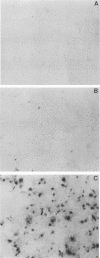Abstract
Envelope glycoprotein E1 (gp51 to gp54) is the most antigenic protein of hog cholera virus or classical swine fever virus (CSFV). Four antigenic domains, A to D, have been mapped on E1 with a panel of monoclonal antibodies (MAbs) raised against CSFV strain Brescia. The boundaries of these domains have been established by extensive studies on binding of MAbs to transiently expressed deletion mutants of E1 (P. A. van Rijn, E. J. de Meijer, H. G. P. van Gennip, and R. J. M. Moormann, J. Gen. Virol. 74:2053-2060, 1993). In this study, we used neutralizing MAbs of domains A, B, and C to isolate MAb-resistant mutants (MAR mutants) of CSFV strain Brescia and Chinese vaccine strain ("C"). The E1 genes of MAR mutants were cloned in a eukaryotic expression vector, and the effects of MAR mutations on epitopes were studied with a panel of 19 MAbs by immunostaining of COS1 cells transiently expressing these mutant E1s. Except for the MAR mutation Cys-->Arg at position 792, which abolished binding of all MAbs of domains A and D, amino acid substitutions affected only MAbs belonging to the same domain as the MAb used to select the MAR mutant. However, a MAR mutation in a particular domain did not per se abolish binding of all MAbs recognizing that domain. Furthermore, MAR mutants possessed conservative as well as nonconservative amino acid substitutions. To investigate the significance of a secondary structure for the binding of MAbs, all cysteine residues in the N-terminal antigenic part of E1 were mutated to serine. We found that the cysteines at positions 693 and 737 were essential for binding by MAbs of domains B and C, whereas those at positions 792, 818, 828, and 856 appeared to be essential for the binding of most MAbs of domains A and D. These results fully comply with the previously proposed two-unit structure of the N-terminal half of E1. One unit consists of antigenic domains B and C, whereas the other unit consists of the highly conserved domain A and domain D. We conclude that the first six cysteines are critical for the correct folding of E1. A model of the antigenic structure of E1 is presented and discussed.
Full text
PDF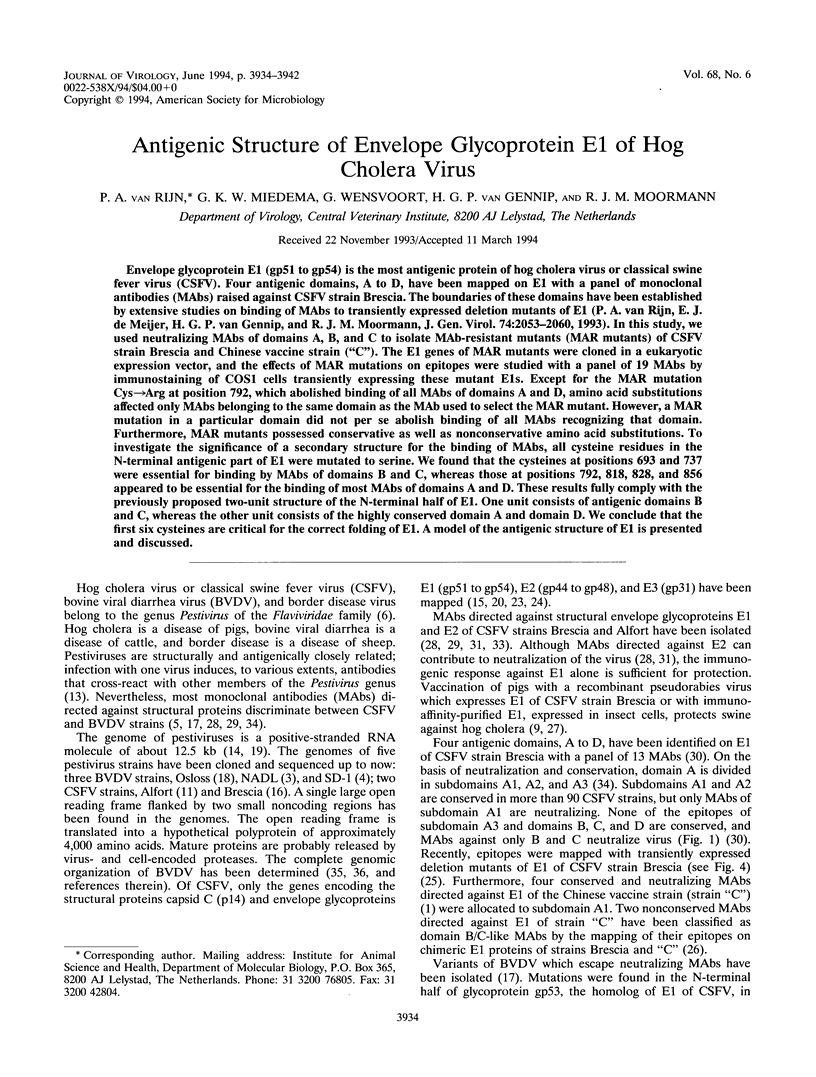
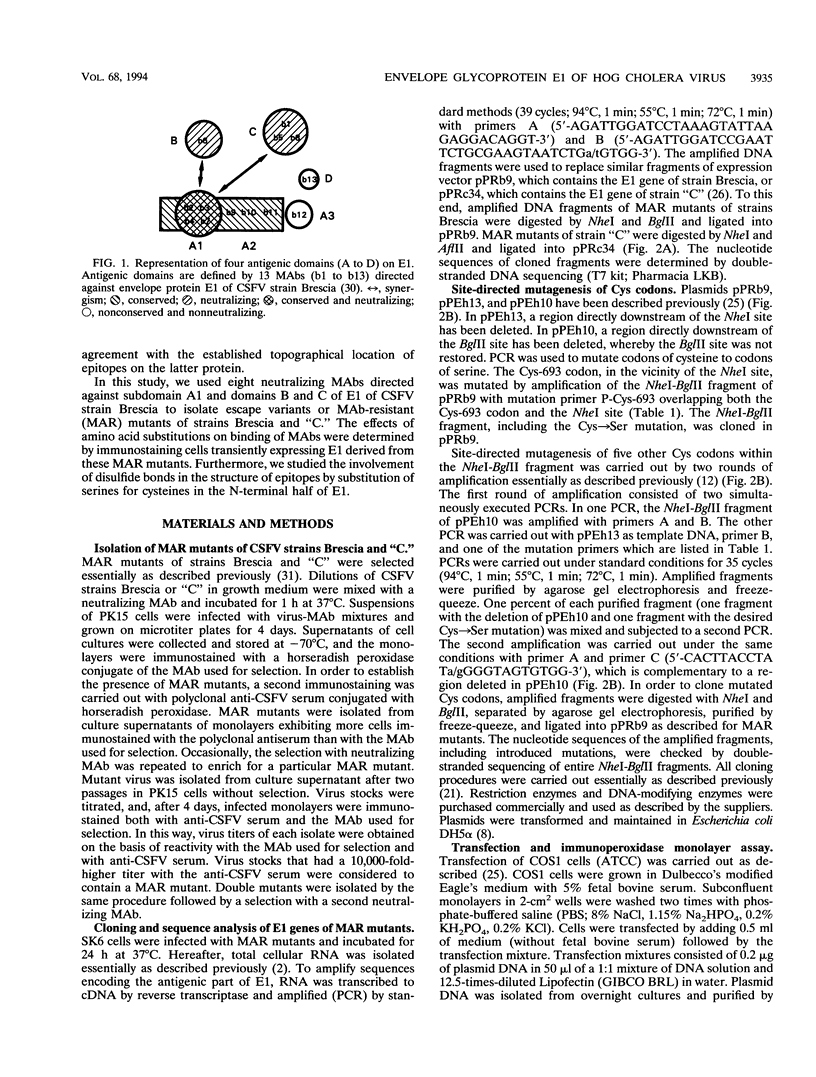
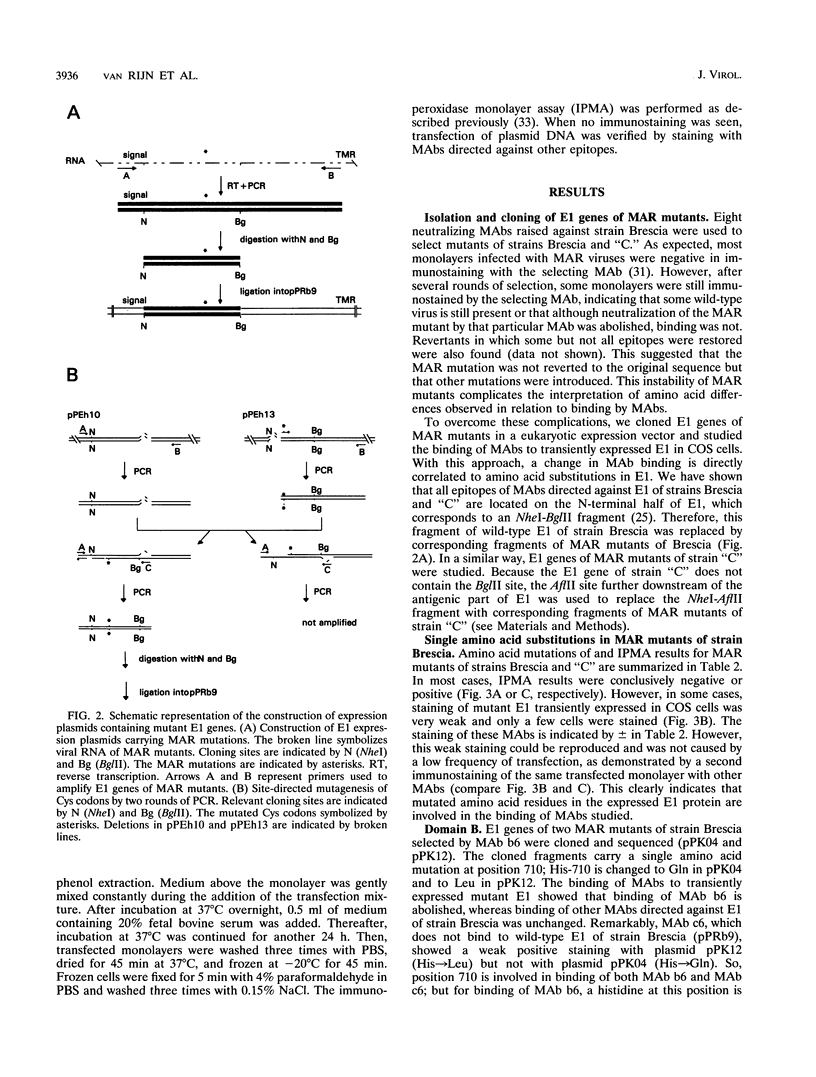
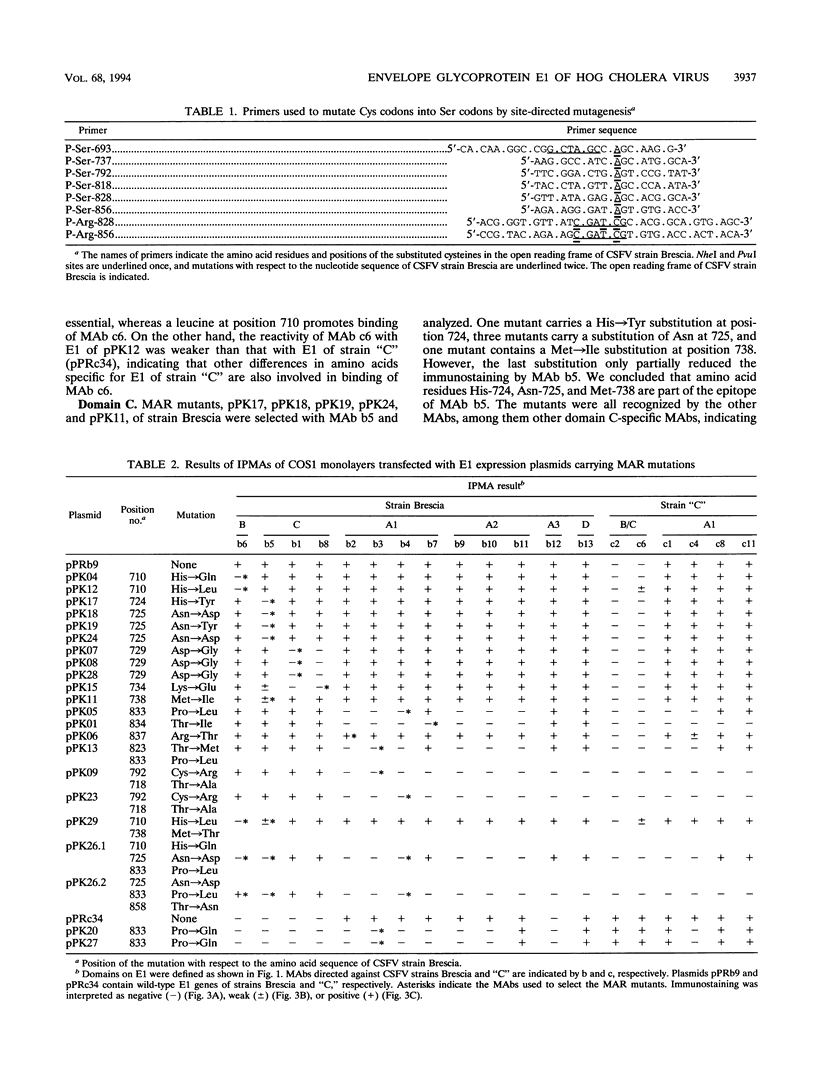
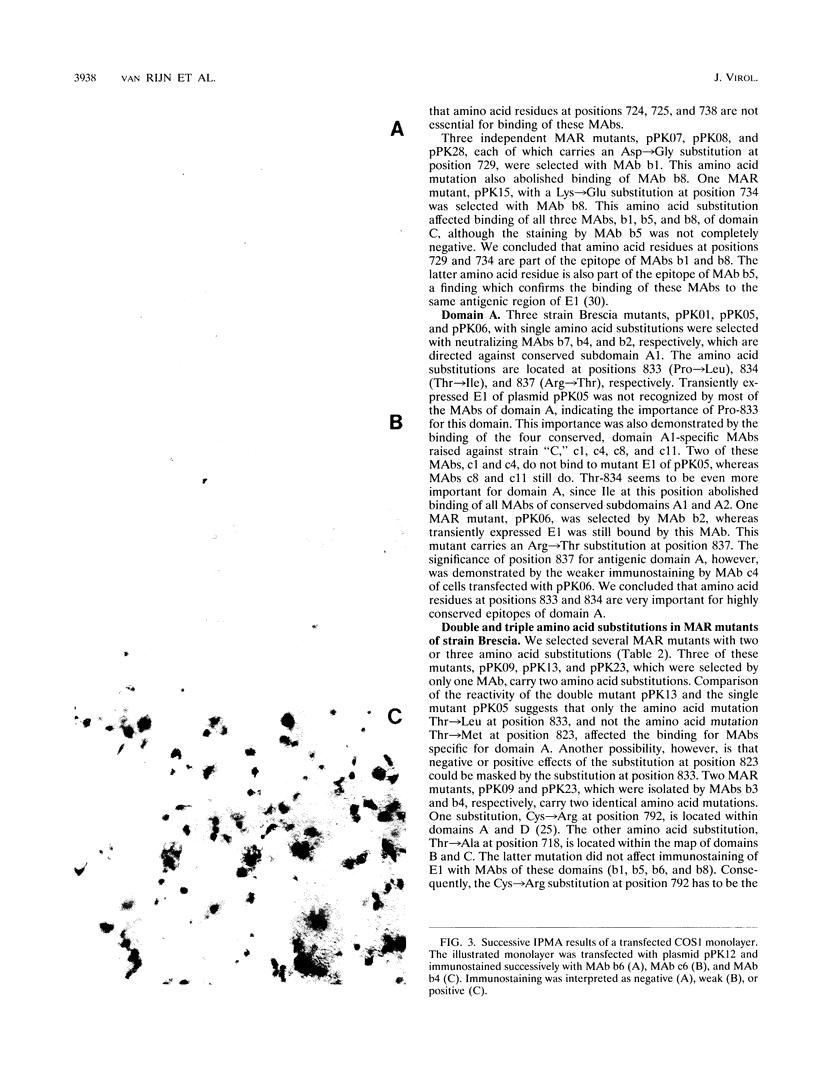
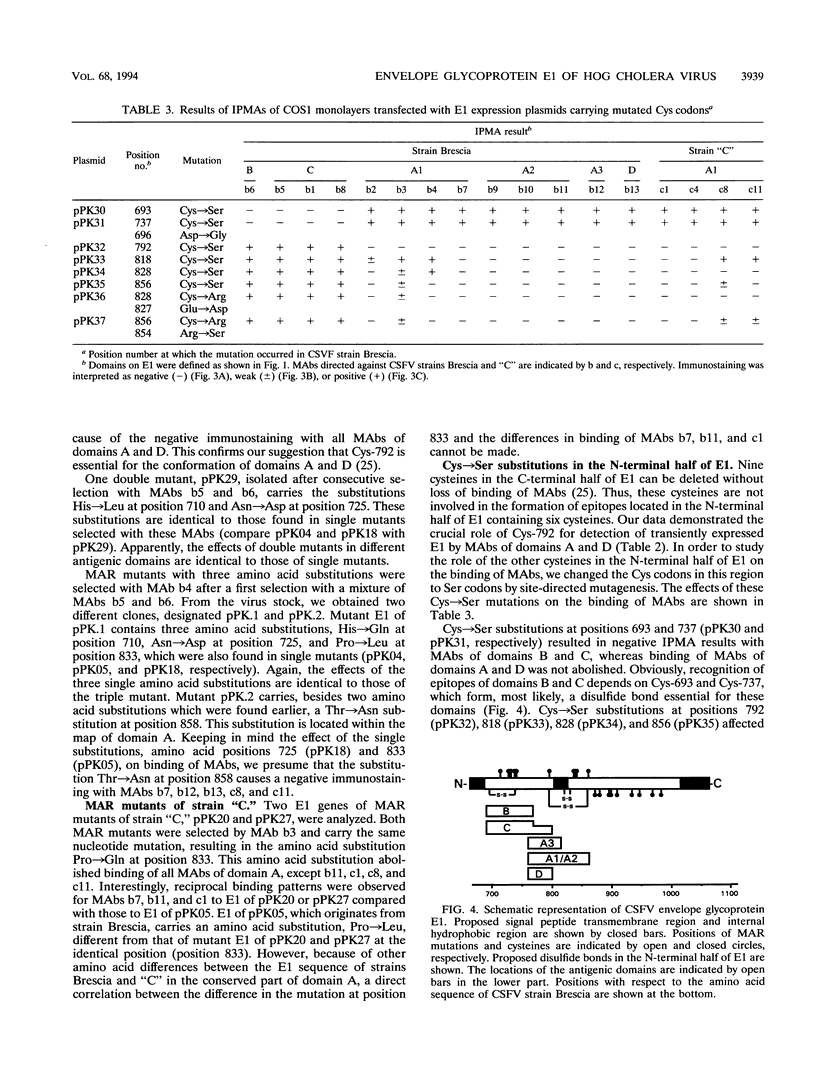
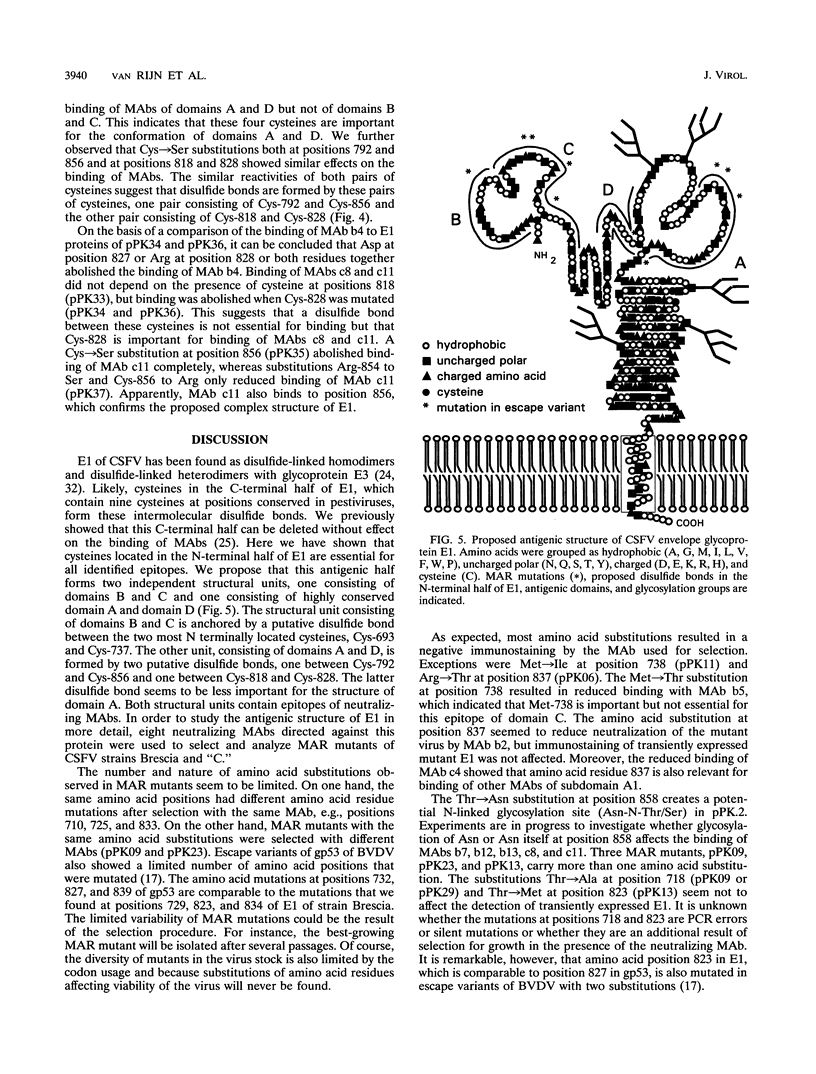

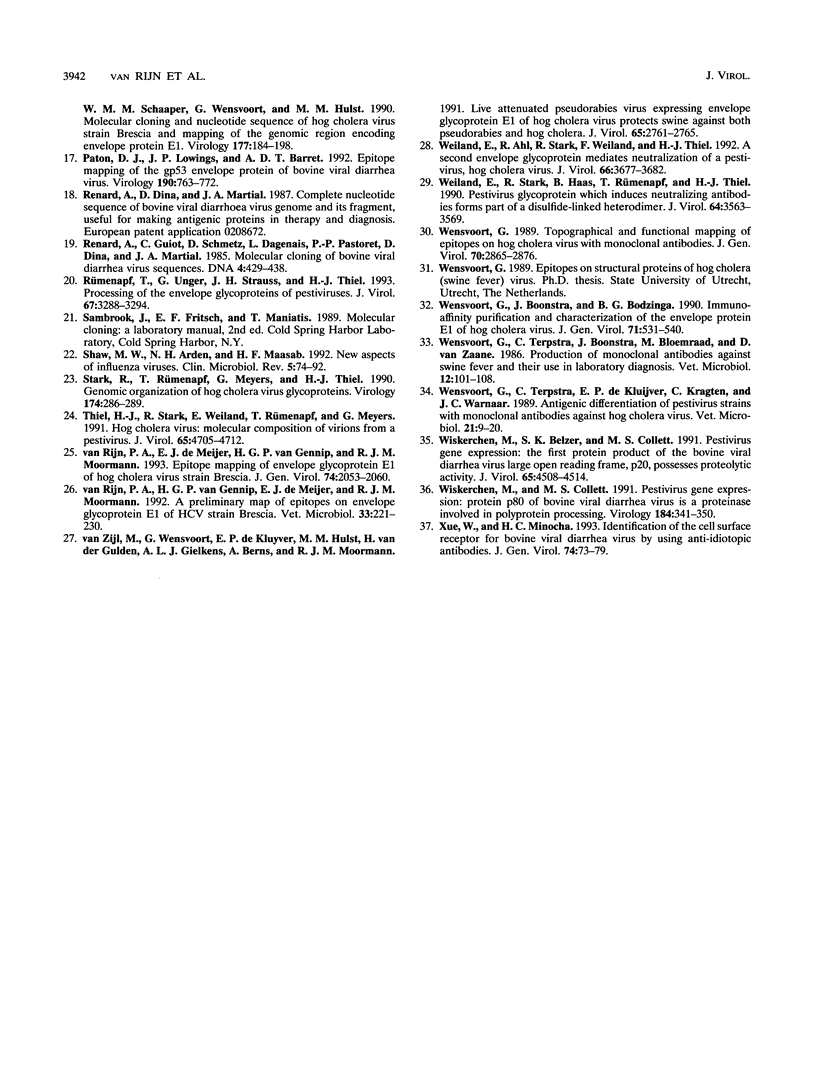
Images in this article
Selected References
These references are in PubMed. This may not be the complete list of references from this article.
- Chomczynski P., Sacchi N. Single-step method of RNA isolation by acid guanidinium thiocyanate-phenol-chloroform extraction. Anal Biochem. 1987 Apr;162(1):156–159. doi: 10.1006/abio.1987.9999. [DOI] [PubMed] [Google Scholar]
- Colett M. S., Larson R., Gold C., Strick D., Anderson D. K., Purchio A. F. Molecular cloning and nucleotide sequence of the pestivirus bovine viral diarrhea virus. Virology. 1988 Jul;165(1):191–199. doi: 10.1016/0042-6822(88)90672-1. [DOI] [PubMed] [Google Scholar]
- Deng R., Brock K. V. Molecular cloning and nucleotide sequence of a pestivirus genome, noncytopathic bovine viral diarrhea virus strain SD-1. Virology. 1992 Dec;191(2):867–869. doi: 10.1016/0042-6822(92)90262-n. [DOI] [PubMed] [Google Scholar]
- Edwards S., Moennig V., Wensvoort G. The development of an international reference panel of monoclonal antibodies for the differentiation of hog cholera virus from other pestiviruses. Vet Microbiol. 1991 Oct;29(2):101–108. doi: 10.1016/0378-1135(91)90118-y. [DOI] [PubMed] [Google Scholar]
- Freed E. O., Myers D. J., Risser R. Characterization of the fusion domain of the human immunodeficiency virus type 1 envelope glycoprotein gp41. Proc Natl Acad Sci U S A. 1990 Jun;87(12):4650–4654. doi: 10.1073/pnas.87.12.4650. [DOI] [PMC free article] [PubMed] [Google Scholar]
- Hulst M. M., Westra D. F., Wensvoort G., Moormann R. J. Glycoprotein E1 of hog cholera virus expressed in insect cells protects swine from hog cholera. J Virol. 1993 Sep;67(9):5435–5442. doi: 10.1128/jvi.67.9.5435-5442.1993. [DOI] [PMC free article] [PubMed] [Google Scholar]
- McCune J. M., Rabin L. B., Feinberg M. B., Lieberman M., Kosek J. C., Reyes G. R., Weissman I. L. Endoproteolytic cleavage of gp160 is required for the activation of human immunodeficiency virus. Cell. 1988 Apr 8;53(1):55–67. doi: 10.1016/0092-8674(88)90487-4. [DOI] [PubMed] [Google Scholar]
- Meyers G., Rümenapf T., Thiel H. J. Molecular cloning and nucleotide sequence of the genome of hog cholera virus. Virology. 1989 Aug;171(2):555–567. doi: 10.1016/0042-6822(89)90625-9. [DOI] [PubMed] [Google Scholar]
- Mikaelian I., Sergeant A. A general and fast method to generate multiple site directed mutations. Nucleic Acids Res. 1992 Jan 25;20(2):376–376. doi: 10.1093/nar/20.2.376. [DOI] [PMC free article] [PubMed] [Google Scholar]
- Moennig V., Plagemann P. G. The pestiviruses. Adv Virus Res. 1992;41:53–98. doi: 10.1016/s0065-3527(08)60035-4. [DOI] [PubMed] [Google Scholar]
- Moormann R. J., Hulst M. M. Hog cholera virus: identification and characterization of the viral RNA and the virus-specific RNA synthesized in infected swine kidney cells. Virus Res. 1988 Nov;11(4):281–291. doi: 10.1016/0168-1702(88)90002-0. [DOI] [PubMed] [Google Scholar]
- Moormann R. J., Warmerdam P. A., van der Meer B., Hulst M. M. Nucleotide sequence of hog cholera virus RNA: properties of the polyprotein encoded by the open reading frame spanning the viral genomic RNA. Vet Microbiol. 1990 Jun;23(1-4):185–191. doi: 10.1016/0378-1135(90)90148-o. [DOI] [PubMed] [Google Scholar]
- Moormann R. J., Warmerdam P. A., van der Meer B., Schaaper W. M., Wensvoort G., Hulst M. M. Molecular cloning and nucleotide sequence of hog cholera virus strain Brescia and mapping of the genomic region encoding envelope protein E1. Virology. 1990 Jul;177(1):184–198. doi: 10.1016/0042-6822(90)90472-4. [DOI] [PubMed] [Google Scholar]
- Paton D. J., Lowings J. P., Barrett A. D. Epitope mapping of the gp53 envelope protein of bovine viral diarrhea virus. Virology. 1992 Oct;190(2):763–772. doi: 10.1016/0042-6822(92)90914-b. [DOI] [PubMed] [Google Scholar]
- Renard A., Guiot C., Schmetz D., Dagenais L., Pastoret P. P., Dina D., Martial J. A. Molecular cloning of bovine viral diarrhea viral sequences. DNA. 1985 Dec;4(6):429–438. doi: 10.1089/dna.1985.4.429. [DOI] [PubMed] [Google Scholar]
- Rümenapf T., Unger G., Strauss J. H., Thiel H. J. Processing of the envelope glycoproteins of pestiviruses. J Virol. 1993 Jun;67(6):3288–3294. doi: 10.1128/jvi.67.6.3288-3294.1993. [DOI] [PMC free article] [PubMed] [Google Scholar]
- Shaw M. W., Arden N. H., Maassab H. F. New aspects of influenza viruses. Clin Microbiol Rev. 1992 Jan;5(1):74–92. doi: 10.1128/cmr.5.1.74. [DOI] [PMC free article] [PubMed] [Google Scholar]
- Stark R., Rümenapf T., Meyers G., Thiel H. J. Genomic localization of hog cholera virus glycoproteins. Virology. 1990 Jan;174(1):286–289. doi: 10.1016/0042-6822(90)90076-4. [DOI] [PubMed] [Google Scholar]
- Thiel H. J., Stark R., Weiland E., Rümenapf T., Meyers G. Hog cholera virus: molecular composition of virions from a pestivirus. J Virol. 1991 Sep;65(9):4705–4712. doi: 10.1128/jvi.65.9.4705-4712.1991. [DOI] [PMC free article] [PubMed] [Google Scholar]
- Weiland E., Ahl R., Stark R., Weiland F., Thiel H. J. A second envelope glycoprotein mediates neutralization of a pestivirus, hog cholera virus. J Virol. 1992 Jun;66(6):3677–3682. doi: 10.1128/jvi.66.6.3677-3682.1992. [DOI] [PMC free article] [PubMed] [Google Scholar]
- Weiland E., Stark R., Haas B., Rümenapf T., Meyers G., Thiel H. J. Pestivirus glycoprotein which induces neutralizing antibodies forms part of a disulfide-linked heterodimer. J Virol. 1990 Aug;64(8):3563–3569. doi: 10.1128/jvi.64.8.3563-3569.1990. [DOI] [PMC free article] [PubMed] [Google Scholar]
- Wensvoort G., Boonstra J., Bodzinga B. G. Immunoaffinity purification and characterization of the envelope protein E1 of hog cholera virus. J Gen Virol. 1990 Mar;71(Pt 3):531–540. doi: 10.1099/0022-1317-71-3-531. [DOI] [PubMed] [Google Scholar]
- Wensvoort G., Terpstra C., Boonstra J., Bloemraad M., Van Zaane D. Production of monoclonal antibodies against swine fever virus and their use in laboratory diagnosis. Vet Microbiol. 1986 Jul;12(2):101–108. doi: 10.1016/0378-1135(86)90072-6. [DOI] [PubMed] [Google Scholar]
- Wensvoort G., Terpstra C., de Kluijver E. P., Kragten C., Warnaar J. C. Antigenic differentiation of pestivirus strains with monoclonal antibodies against hog cholera virus. Vet Microbiol. 1989 Nov;21(1):9–20. doi: 10.1016/0378-1135(89)90014-x. [DOI] [PubMed] [Google Scholar]
- Wensvoort G. Topographical and functional mapping of epitopes on hog cholera virus with monoclonal antibodies. J Gen Virol. 1989 Nov;70(Pt 11):2865–2876. doi: 10.1099/0022-1317-70-11-2865. [DOI] [PubMed] [Google Scholar]
- Wiskerchen M., Belzer S. K., Collett M. S. Pestivirus gene expression: the first protein product of the bovine viral diarrhea virus large open reading frame, p20, possesses proteolytic activity. J Virol. 1991 Aug;65(8):4508–4514. doi: 10.1128/jvi.65.8.4508-4514.1991. [DOI] [PMC free article] [PubMed] [Google Scholar]
- Wiskerchen M., Collett M. S. Pestivirus gene expression: protein p80 of bovine viral diarrhea virus is a proteinase involved in polyprotein processing. Virology. 1991 Sep;184(1):341–350. doi: 10.1016/0042-6822(91)90850-b. [DOI] [PubMed] [Google Scholar]
- Xue W., Minocha H. C. Identification of the cell surface receptor for bovine viral diarrhoea virus by using anti-idiotypic antibodies. J Gen Virol. 1993 Jan;74(Pt 1):73–79. doi: 10.1099/0022-1317-74-1-73. [DOI] [PubMed] [Google Scholar]
- van Rijn P. A., van Gennip H. G., de Meijer E. J., Moormann R. J. Epitope mapping of envelope glycoprotein E1 of hog cholera virus strain Brescia. J Gen Virol. 1993 Oct;74(Pt 10):2053–2060. doi: 10.1099/0022-1317-74-10-2053. [DOI] [PubMed] [Google Scholar]
- van Rijn P. A., van Gennip R. G., de Meijer E. J., Moormann R. J. A preliminary map of epitopes on envelope glycoprotein E1 of HCV strain Brescia. Vet Microbiol. 1992 Nov;33(1-4):221–230. doi: 10.1016/0378-1135(92)90050-4. [DOI] [PubMed] [Google Scholar]
- van Zijl M., Wensvoort G., de Kluyver E., Hulst M., van der Gulden H., Gielkens A., Berns A., Moormann R. Live attenuated pseudorabies virus expressing envelope glycoprotein E1 of hog cholera virus protects swine against both pseudorabies and hog cholera. J Virol. 1991 May;65(5):2761–2765. doi: 10.1128/jvi.65.5.2761-2765.1991. [DOI] [PMC free article] [PubMed] [Google Scholar]



